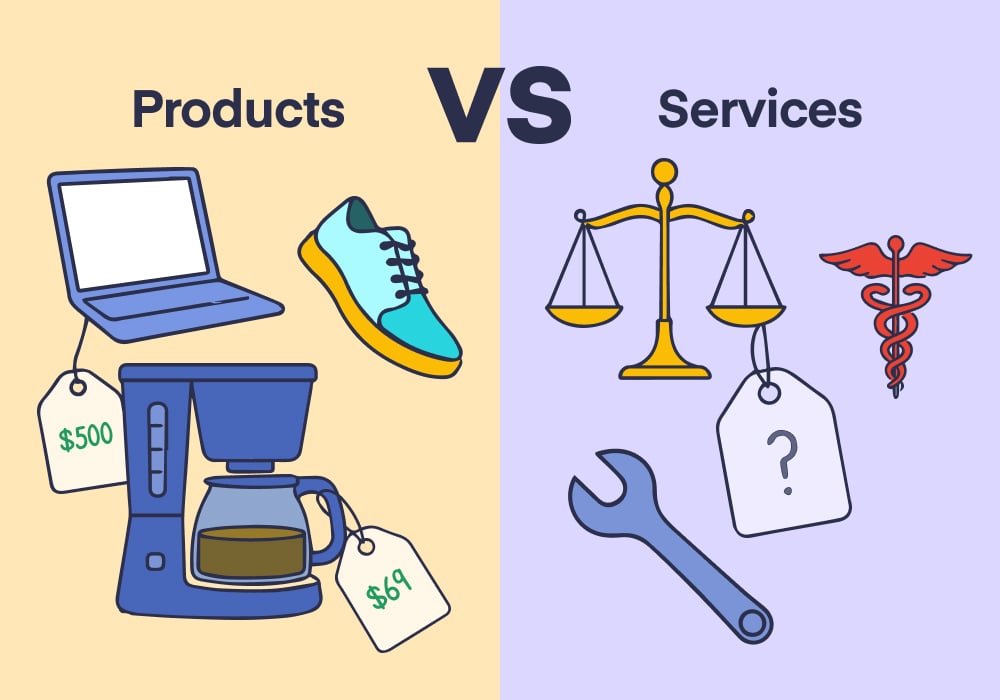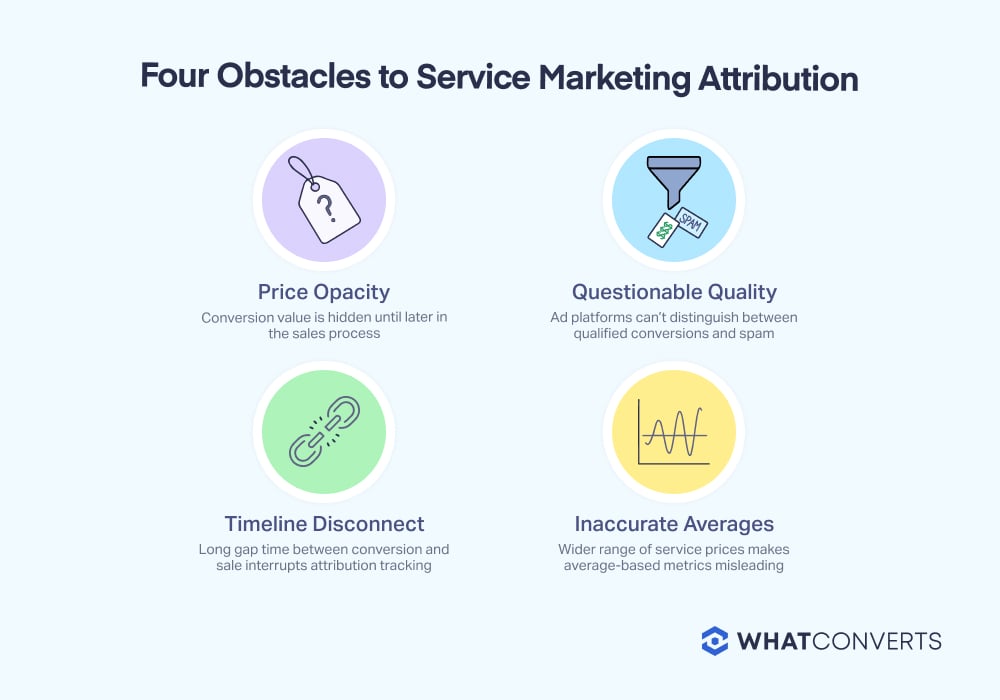
In the marketing world, e-commerce has an advantage: each conversion is recorded with its value attached.
When someone clicks a Google Ad and buys a $100 product, it’s documented as a $100 conversion. When it comes time to evaluate which ads, keywords, and campaigns generate the most revenue, that data is immediately available.
But when you’re marketing services, there’s a gap between the conversion and the sale. So when a $50,000 client clicks on an ad and submits a form, Google has no way of documenting the value of that conversion—because the value isn’t known yet. When they do eventually sign that $50,000 contract, that data never makes it back to the platform.
Luckily, it’s possible to bridge that timeline gap and bring clarity to the value of your service marketing ads and campaigns.
The Four Invisible Barriers of Service Marketing Attribution
It’s not just the timeline gap that gets in the way of proper value attribution in service-based marketing. There are four distinct obstacles that make it difficult for service marketers to accurately measure their own success.
Price Opacity: When a Conversion Hides Its Worth
In e-commerce, a customer’s value is clearly defined as soon as they complete a purchase conversion. When they convert, they go from prospect to “$50 customer” or “$100/month subscriber.”
When a potential customer completes a conversion action for a service—places a call, books an appointment, fills out a form—they just become a “potential lead.” How much they’re ultimately worth depends on the price of the service they’re interested in, which isn’t one of the data points that’s captured in a standard conversion.
This price opacity creates a massive blind spot. When your marketing platforms can’t distinguish between a lead that will go on to spend $10,000 and one that will only spend $100, it’s impossible to measure how successful your ads and campaigns really are when it comes to actually generating revenue. Without that data, they optimize with the information they have: raw number of conversions. All of those conversions, whether they’re big clients or totally worthless, are treated the same.
Questionable Quality: Good Leads vs. Bad Leads
Marketing platforms can’t see how much money a converted prospect might actually spend—and in fact, they can’t tell whether there’s any chance of them spending money at all.
That prospect that’s going to spend $100 isn’t bringing in a huge value, but they’re still a qualified customer with potentially greater future value. But lots of your conversions will come from sources that have no shot of ever becoming customers—spam bots, people outside your service area, existing clients that clicked a paid ad accidentally, and even competitors researching your services.
To marketing platforms like Google Ads, these worthless conversions look identical to your highest-potential leads. This quality invisibility means your campaigns might optimize toward generating more of the wrong kind of conversions—a costly misdirection that undermines your marketing ROI.
Read More: Home Services Agency Achieves 92% Fewer Unqualified Leads in Under 5 Minutes [Case Study]
Timeline Disconnection: The Dark Period Between Lead and Revenue
Service businesses typically have longer sales cycles than product businesses. While an e-commerce purchase might happen instantly, service sales often involve multiple touchpoints over weeks or months before resulting in a conversion—and that ultimate conversion might happen offline, where it’s not attributed to any marketing at all.
This timeline disconnection creates a "dark period" where marketing platforms lose sight of what happens to leads after the initial conversion. By the time a lead becomes a paying client, the connection to the original marketing source has often been lost or fragmented.
Traditional attribution models struggle with this extended timeline. Last-click attribution ignores the nurturing journey. Even multi-touch models rarely extend far enough to capture the full path from first awareness to final service purchase.
Varied Value: When Not All Customers Are Created Equal
Service businesses often have significantly higher value variability than product businesses. While an e-commerce store might sell products ranging from $20 to $200, a service business might have engagements ranging from $500 to $50,000.
This wide range of potential values makes average-based metrics dangerously misleading. A campaign generating ten $1,000 clients might look identical in conversion metrics to one generating a single $50,000 client—yet the business impact differs dramatically.
This value variability means service businesses need more nuanced measurement approaches that capture not just lead quantity but also the varying potential and actual values of those leads.
The Hidden Cost of Flying Blind
These attribution barriers aren't just theoretical problems—they directly impact your marketing effectiveness and bottom line.
Campaign Misdirection: Optimizing for the Wrong Things
Without visibility into lead quality and value, marketers inevitably optimize for the wrong metrics. They chase higher conversion rates and lower cost-per-lead figures, even when those improvements don't translate to better business outcomes.
This campaign misdirection leads to concrete consequences:
- Wasted budget on campaigns that generate high volumes of low-quality leads
- Underinvestment in channels that bring fewer but more valuable clients
- Misallocated resources toward keywords and audiences that convert but don't contribute to revenue
- Abandoned campaigns that were actually delivering value but didn't show strong conversion metrics
The opportunity cost here is substantial. Every dollar spent generating worthless leads is a dollar not invested in attracting your ideal clients.
Algorithmic Limitations: Teaching Google What Actually Matters
Modern marketing relies heavily on machine learning algorithms to optimize campaigns. These algorithms are incredibly powerful—when they have the right data. For service businesses, therein lies the problem.
Google's automated bidding systems are designed to optimize toward conversions or conversion value. Without quality and value signals, these algorithms operate with a critical blind spot. They can't distinguish between high-potential and no-potential leads, so they optimize for what they can measure: raw conversion volume.
This creates a significant competitive disadvantage for service businesses compared to e-commerce operations. While product marketers feed rich purchase data back to these algorithms, service marketers often provide only binary conversion signals that lack quality and value dimensions.
Connecting Marketing to True Service Value
Despite these challenges, service businesses can implement strategies to connect marketing efforts with actual business value. The key is to create visibility where opacity previously existed.
The Value Visibility Framework
The most effective approach to service marketing measurement follows a three-part framework:
- Capture individual lead data: Move beyond anonymous conversion tracking to identify and track individual leads. This means collecting detailed information about each prospect that interacts with your marketing.
- Qualify your leads: Establish a process for evaluating the quality of each lead based on criteria specific to your business. This qualification should happen as close to the initial conversion as possible.
- Connect marketing to outcomes: Create systems that maintain the thread between marketing sources and ultimate business outcomes, whether those are signed contracts, service engagements, or ongoing client relationships.
This framework transforms vague conversion data into specific, actionable insights about which marketing efforts drive actual business value.
From Invisible to Visible: Practical Attribution Strategies
Implementing the value visibility framework requires specific strategies to overcome each attribution barrier:
To address value opacity, assign quote values based on service interest indicators. For instance, if you offer two services that cost $1,000 and $5,000 respectively, you can assign those values to new leads depending on which service they’re interested in.
To eliminate quality invisibility, establish clear qualification criteria and systematically apply them to incoming leads. Whether through manual review, automated scoring, or a combination of both, categorizing leads as qualified or unqualified creates essential visibility for marketing optimization.
To overcome timeline disconnection, implement consistent lead tracking from first touch to final purchase. This requires you to maintain identifier continuity across marketing platforms, CRM systems, and sales processes so that revenue can be accurately attributed to its marketing sources.
To solve value variability, segment your analysis by service lines and client tiers rather than relying on overall averages. This more granular approach recognizes the different value profiles across your business and allows for targeted optimization within each segment.
Tools like WhatConverts can help implement these strategies by capturing detailed information about each lead, maintaining marketing source data, and allowing you to mark leads as qualified or unqualified. This creates the visibility needed to accurately measure marketing effectiveness for service businesses.
Competing on Value in a Conversion-Obsessed World
Service marketing in a product-obsessed world presents unique challenges, particularly when it comes to connecting marketing efforts with business outcomes. The invisibility of lead quality and value creates a fundamental attribution gap that undermines marketing effectiveness.
However, by implementing strategies that create visibility into what truly matters—qualified leads that generate actual revenue—service businesses can transform their marketing approach. The shift from conversion obsession to value focus doesn't just improve measurement; it fundamentally changes how you market your services.
When you know which marketing efforts truly drive business value, you can make confident decisions about where to invest, what messages resonate with your ideal clients, and how to optimize campaigns for quality over quantity. This value visibility becomes a significant competitive advantage in markets where most competitors still chase meaningless conversion metrics.
The future of service marketing lies not in mimicking product marketing tactics but in developing measurement approaches specifically designed for the unique nature of service businesses. By focusing on lead quality, value attribution, and closed-loop measurement, you can ensure your marketing efforts truly contribute to business growth—even when the value isn't immediately visible.
Ready to start gaining visibility into your service marketing campaign success? Start your free 14-day trial or schedule a demo today.
Get a FREE presentation of WhatConverts
One of our marketing experts will give you a full presentation of how WhatConverts can help you grow your business.
Schedule a Demo
Grow your business with WhatConverts






